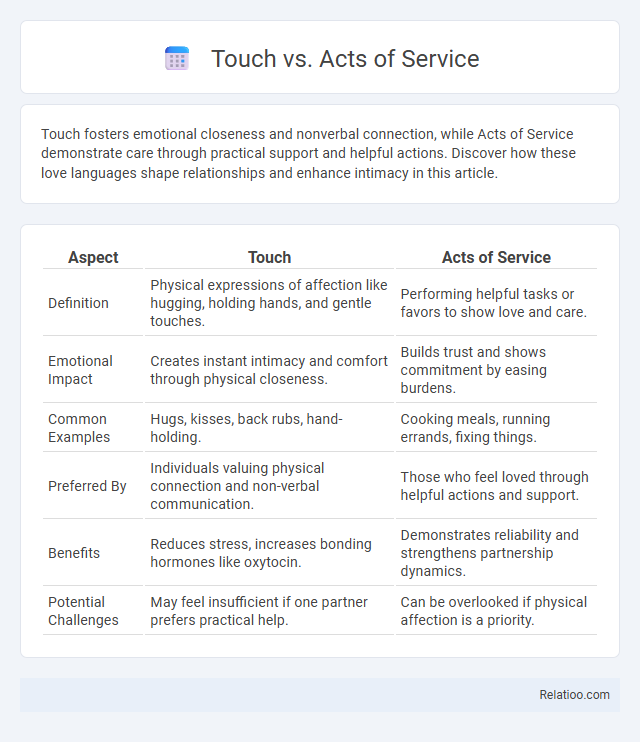Touch fosters emotional closeness and nonverbal connection, while Acts of Service demonstrate care through practical support and helpful actions. Discover how these love languages shape relationships and enhance intimacy in this article.
Table of Comparison
| Aspect | Touch | Acts of Service |
|---|---|---|
| Definition | Physical expressions of affection like hugging, holding hands, and gentle touches. | Performing helpful tasks or favors to show love and care. |
| Emotional Impact | Creates instant intimacy and comfort through physical closeness. | Builds trust and shows commitment by easing burdens. |
| Common Examples | Hugs, kisses, back rubs, hand-holding. | Cooking meals, running errands, fixing things. |
| Preferred By | Individuals valuing physical connection and non-verbal communication. | Those who feel loved through helpful actions and support. |
| Benefits | Reduces stress, increases bonding hormones like oxytocin. | Demonstrates reliability and strengthens partnership dynamics. |
| Potential Challenges | May feel insufficient if one partner prefers practical help. | Can be overlooked if physical affection is a priority. |
Understanding Touch and Acts of Service
Understanding touch as a primary love language involves appreciating physical affection such as hugs, holding hands, and gentle touches that convey warmth and connection. Acts of Service express love through helpful actions like cooking meals, running errands, or doing chores, demonstrating care by easing a partner's burdens. Recognizing the distinction between these two involves noting that touch communicates emotional intimacy directly through physical presence, while acts of service show love through practical support and effort.
The Psychology Behind Love Languages
The psychology behind love languages reveals that Touch, Acts of Service, and Words of Affirmation each activate distinct emotional and attachment responses in the brain, influencing how individuals perceive and feel loved. Physical Touch releases oxytocin, fostering bonding and security, while Acts of Service engage cognitive appreciation through meaningful actions, which increases perceived support and partnership. Words of Affirmation stimulate neural pathways associated with positive reinforcement, strengthening emotional connection through verbal validation and encouragement.
Key Differences Between Touch and Acts of Service
Touch as a love language revolves around physical contact, such as hugs, hand-holding, or gentle touches, conveying affection and connection directly through the body. Acts of Service involve performing helpful tasks or favors, like cooking a meal or running errands, to express love by easing the partner's responsibilities. The key difference between Touch and Acts of Service lies in the mode of expression--Touch communicates intimacy through physical closeness, while Acts of Service emphasize practical support and effort to demonstrate care.
How Touch Expresses Affection
Touch conveys affection through physical closeness, creating a direct sensory connection that fosters trust and emotional intimacy. Unlike Acts of Service, which express care through actions, touch communicates feelings instantly and viscerally, often reducing stress and enhancing bonding via oxytocin release. Hugs, gentle caresses, and hand-holding serve as powerful nonverbal signals that strengthen relationships by affirming presence and support.
Acts of Service: Showing Love Through Actions
Acts of Service demonstrates love through tangible efforts such as helping with chores, running errands, or offering support during stressful times, reflecting deep care beyond words. Unlike Touch, which emphasizes physical affection, Acts of Service prioritizes actions that ease a partner's burden and reinforce emotional security. This love language fosters trust and connection by consistently proving commitment through meaningful deeds.
Recognizing Your Partner’s Love Language
Recognizing your partner's love language is crucial for strengthening emotional intimacy and ensuring your gestures truly resonate. Touch, Acts of Service, and Words of Affirmation each communicate love uniquely, with Touch emphasizing physical closeness and Acts of Service highlighting helpful actions that ease your partner's life. Understanding these distinctions enables you to express affection in ways that feel authentic and deeply appreciated by your partner.
Benefits and Challenges of Touch
Touch fosters deep emotional connection and enhances physical well-being by releasing oxytocin, reducing stress, and promoting trust in relationships. You might face challenges such as personal boundaries, cultural differences, or discomfort with physical closeness, requiring clear communication to ensure mutual consent. Balancing the powerful benefits of touch with respect for individual preferences strengthens intimacy and promotes healing.
The Power of Acts of Service in Relationships
Acts of Service strengthen relationships by demonstrating care through tangible actions, creating a deeper emotional connection than words alone. Performing meaningful tasks like helping with chores or running errands conveys love and reliability, fostering trust and mutual support. This love language often builds long-lasting bonds rooted in consistent, thoughtful efforts that speak louder than physical touch or verbal affirmations.
Balancing Touch and Acts of Service
Balancing touch and acts of service involves recognizing the unique emotional needs they fulfill in a relationship; physical touch conveys intimacy and connection, while acts of service demonstrate care through tangible actions. You can create a harmonious bond by attentively combining affectionate gestures like hugs or hand-holding with helpful deeds such as cooking or running errands. Prioritizing both physical affection and practical support enriches communication and strengthens emotional intimacy.
Nurturing Connection Through Love Languages
Touch fosters intimacy and reassurance by creating physical closeness that conveys affection without words. Acts of Service demonstrate care through thoughtful actions, addressing needs and easing burdens to build trust and support. Your ability to balance Touch and Acts of Service nurtures a deeper emotional bond, enhancing connection through personalized love languages.

Infographic: Touch vs Acts of Service
 relatioo.com
relatioo.com